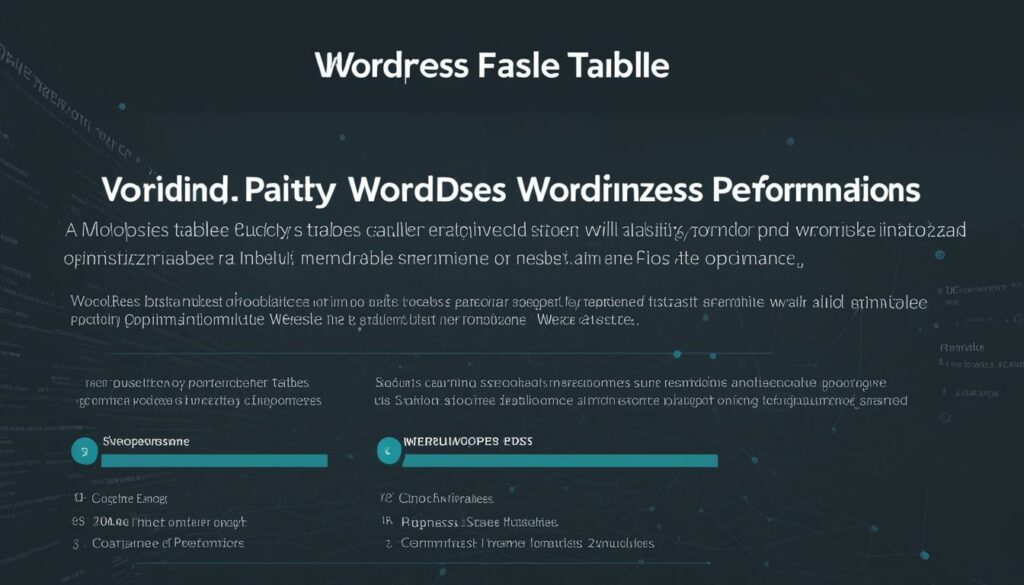In today’s fast-paced digital world, a slow-loading website can be a major turn-off for visitors. If your WordPress website takes forever to load, it’s time to consider optimizing your database. By enhancing your database performance and streamlining speed, you can ensure that users have a smooth browsing experience and boost the overall speed of your WordPress website.
Optimizing your WordPress database involves a series of techniques aimed at improving its performance, reducing page load times, and enhancing overall user satisfaction. With the right database optimization techniques, you can make your WordPress site faster, more efficient, and ultimately more successful.
Key Takeaways:
- Optimizing your WordPress database is crucial for improving website performance and user experience.
- By optimizing the database, you can achieve faster page load times and enhance user satisfaction.
- Optimized databases contribute to improved search rankings and reduce the risk of errors.
- Efficient resource utilization, scalability, and data security are additional benefits of database optimization.
- Repairing and optimizing a database are two different processes, with each serving a distinct purpose.
We recommend WordPress Hosting from BoostedHost for optimal performance. Sign up now through this link: www.boostedhost.com/wordpress-hosting.
Importance of WordPress Database Optimization
Optimizing your WordPress database is essential for enhancing your website’s performance and delivering an exceptional user experience. By optimizing the database, you can achieve faster page load times, improve search rankings, and reduce the risk of errors. Additionally, database optimization enables efficient resource utilization, scalability, data security, and better plugin and theme performance. It is a cost-effective solution that improves overall website performance without requiring expensive server upgrades or additional resources.
When you optimize your WordPress database, you can enjoy the following benefits:
- Faster page load times: A well-optimized database ensures that your website loads quickly, providing visitors with a seamless and enjoyable browsing experience.
- Enhanced user experience: Faster page load times contribute to improved user satisfaction, increased engagement, and higher conversion rates.
- Improved search rankings: Search engines prioritize fast-loading websites, so optimizing your database can positively impact your website’s search engine rankings.
Furthermore, WordPress database optimization offers:
- Reduced risk of errors: By optimizing your database, you minimize the chance of encountering database-related errors, ensuring the stability and reliability of your website.
- Efficient resource utilization: An optimized database efficiently utilizes server resources, allowing your website to handle increased traffic without experiencing slowdowns or crashes.
- Scalability: An optimized database provides a solid foundation for scaling your website as your business grows, allowing you to handle larger volumes of data and increased user demand.
- Data security: Database optimization helps ensure the security of your website’s data, minimizing vulnerabilities that could lead to unauthorized access or data breaches.
- Better plugin and theme performance: An optimized database improves the performance of plugins and themes, enabling them to function more efficiently and deliver a seamless user experience.
- Cost-effective solution: Optimizing your database is a cost-effective way to improve your website’s performance, as it doesn’t require expensive hardware upgrades or additional server resources.
By prioritizing WordPress database optimization, you can ensure that your website delivers faster page load times, enhances the user experience, and improves search rankings. Additionally, you’ll reduce the risk of errors, efficiently utilize resources, enhance data security, and unlock better performance from your plugins and themes. This cost-effective solution allows you to optimize your website’s performance without breaking the bank.
Difference Between Repair and Optimize Database
When it comes to database management, it’s important to understand the difference between repairing and optimizing your database. Each process serves a unique purpose and contributes to improving database performance in its own way.
Repairing a database involves identifying and fixing specific issues or errors within the database that are causing problems. This could include fixing corrupted or damaged tables, resolving conflicts, or addressing other issues that may result in data loss or incorrect data retrieval. By repairing the database, you can ensure the integrity and stability of your data.
On the other hand, optimizing a database focuses on cleaning and organizing the data to improve its overall performance and speed. This involves tasks such as removing unnecessary or redundant data, reducing the size of the database, and optimizing its structure. By optimizing the database, you can enhance query performance, reduce data retrieval time, and improve overall efficiency.
Both processes are essential for maintaining a healthy and efficient database. While repairing addresses specific issues, optimizing ensures that your database operates at its best by eliminating any bottlenecks or inefficiencies. By combining these two processes, you can achieve a well-maintained and high-performing database.
Repairing the Database
Repairing a database involves identifying and fixing specific issues or errors within the database that are causing problems.
When it comes to repairing your database, you need to be proactive in identifying any issues or errors. This can involve regular database maintenance, monitoring for errors, and performing routine checks to ensure the integrity of your data. Some common issues that may require database repair include:
- Corrupted or damaged tables
- Inconsistent or incorrect data
- Slow or failed queries
- Conflicts between different components or plugins
By addressing these issues promptly and effectively, you can prevent data loss, improve data accuracy, and ensure the smooth functioning of your database.
Optimizing the Database
Optimizing a database focuses on cleaning and organizing the data to improve its overall performance and speed.
Optimizing your database involves various tasks aimed at improving its performance and efficiency. Some common optimization techniques include:
- Cleaning up unnecessary or redundant data
- Removing expired or stale data
- Reducing the size of the database
- Optimizing the database structure
- Defragmenting the database to improve data access
- Optimizing queries for better performance
By optimizing your database, you can enhance query execution time, reduce the storage space required, and improve overall system performance.
Did you know?
Optimizing your database not only improves performance but also contributes to better scalability and cost-effectiveness. By reducing the database size and improving query performance, you can utilize your server resources more efficiently and avoid costly hardware upgrades.
Understanding WordPress Database Structure
To effectively optimize your WordPress database, it is important to understand its structure. The WordPress database is composed of various tables that store different types of data. By gaining insights into the database structure and the purpose of each table, you can efficiently manage and optimize your database.
Key Tables in WordPress Database
Here are some important tables in the WordPress database:
| Table Name | Description |
|---|---|
| wp_users | This table stores user information such as usernames, email addresses, and passwords. |
| wp_usermeta | This table contains additional metadata associated with user profiles, including user roles and custom field values. |
| wp_posts | All posts and pages on your WordPress website are stored in this table. It includes data such as titles, content, and publication dates. |
| wp_postmeta | This table stores additional metadata related to posts and pages, such as custom fields, post revisions, and featured images. |
| wp_comments | All comments made on your WordPress website are stored in this table along with relevant information like comment author, date, and content. |
| wp_commentmeta | Similar to wp_postmeta, this table contains additional metadata associated with comments, such as comment parent, spam status, and user agent. |
| wp_terms | This table stores the taxonomy terms used for categorizing posts, such as tags and categories. |
| wp_termmeta | Additional metadata related to taxonomy terms is stored in this table, allowing for customization of term attributes. |
| wp_term_relationships | This table establishes relationships between posts and their associated taxonomy terms. |
| wp_term_taxonomy | It defines the taxonomies used in your WordPress website and assigns them to specific terms. |
| wp_links | This table is used for managing and storing links or URLs that can be displayed on your website. |
Being familiar with the structure and purpose of these tables will empower you to efficiently optimize your WordPress database, eliminating unnecessary data, improving performance, and enhancing the overall user experience.
Prerequisites for WordPress Database Optimization
Before you begin optimizing your WordPress database, there are a few important prerequisites that you need to fulfill. These prerequisites will ensure a smooth and secure optimization process without the risk of data loss or issues.
1. Backup your database
Backing up your database is the first and most critical step before starting any optimization. It ensures that you have a copy of your database in case something goes wrong during the optimization process. By backing up your database, you can easily restore it to its previous state if needed.
Image:

2. Identify and fix database errors
Before optimizing your database, it is important to identify and fix any existing errors or issues. This step ensures that your database is in good condition and free from any potential problems that could cause complications during the optimization process. It is recommended to run a thorough database check to identify and resolve any errors beforehand.
“Identifying and fixing any database errors is crucial to ensure the smooth optimization of your WordPress database.”
By following these prerequisites, you can be well-prepared and confident in optimizing your WordPress database for improved performance and efficiency.
| Prerequisites for WordPress Database Optimization |
|---|
| Backup your database |
| Identify and fix database errors |
We recommend WordPress Hosting from BoostedHost for optimal performance. Sign up now through this link: www.boostedhost.com/wordpress-hosting.
Method 1: Optimize WordPress Database via phpMyAdmin
Optimizing your WordPress database is essential for maintaining optimal website performance. One effective method for optimizing your database is by utilizing phpMyAdmin, a web-based interface that allows you to manage your database directly.
With phpMyAdmin, you can perform various optimization tasks to ensure that your database is clean and efficient. Here are some steps you can take:
- Clean up unnecessary data: Remove spam comments, post revisions, and expired transients that may be clogging up your database and slowing down queries.
- Optimize database tables: By optimizing your database tables, you can remove any unused tables and reorganize the data to improve overall efficiency.
- Optimize database indexes: Indexes play a crucial role in query performance. By optimizing your database indexes, you can speed up query execution and improve overall database performance.
- Compress database files: Compressing your database files reduces their size, making them quicker to load and improving overall website speed.
Performing these optimizations manually via phpMyAdmin may require some technical know-how. However, it provides you with direct control over the optimization process and allows you to fine-tune your database to your specific needs.
Pro Tip: As database optimization can be a complex task, it’s always recommended to backup your database before making any changes. In case anything goes wrong, you can easily restore your data to its previous state.

| Task | Optimization Action |
|---|---|
| Clean up unnecessary data | Remove spam comments, post revisions, expired transients |
| Optimize database tables | Remove unused tables, reorganize data |
| Optimize database indexes | Speed up query execution |
| Compress database files | Reduce file size, improve website speed |
Optimizing your WordPress database via phpMyAdmin can significantly improve your website’s performance by cleaning up unnecessary data, optimizing tables and indexes, and compressing database files. However, if you prefer a more user-friendly approach, there are also plugins available that can automate the optimization process.
Method 2: Optimize WordPress Database via Plugins
If you want to optimize your WordPress database but don’t have technical expertise, plugins can be a great solution. With the help of database optimization plugins, you can automate the optimization process and improve your website’s performance without hassle.
These plugins offer a range of features that can benefit your website. Firstly, they help remove unnecessary data that may be cluttering your database, such as spam comments, post revisions, and expired transients. By eliminating this excess data, you can streamline your database and improve its efficiency.
Additionally, database optimization plugins can optimize your database queries. By fine-tuning the way your website interacts with the database, these plugins ensure that your queries are executed more efficiently, resulting in faster page load times and improved performance.
Regular database maintenance is critical for optimal performance. These plugins make it easy to perform routine tasks such as optimizing and repairing database tables. Regular maintenance ensures that your database remains in good health, minimizing the risk of errors and data corruption.
One of the significant advantages of using database optimization plugins is that they can help limit the number of database queries. By reducing the number of queries your website makes to the database, you can significantly improve performance and enhance the user experience.
Tip: Boost your WordPress website’s performance by signing up for WordPress Hosting from BoostedHost. Optimize your WordPress database and enjoy faster-loading pages!
Using plugins to optimize your WordPress database simplifies the process, allowing you to focus on other aspects of your website. With a wide range of database optimization plugins available, you can choose the one that best suits your needs and preferences.
Popular Database Optimization Plugins:
| Plugin | Features |
|---|---|
| WP-Optimize | Automated cleaning and optimization |
| WP-Sweep | Data removal and optimization |
| WP Rocket | Caching and optimization features |
| Advanced Database Cleaner | Comprehensive database cleaning |
| WP Smush | Image optimization in the database |
These popular plugins offer various functionalities, allowing you to optimize your WordPress database and achieve better performance. Choose the plugin that aligns with your specific requirements and enjoy a seamlessly optimized database.

Best Plugins for WordPress Database Optimization
When it comes to optimizing your WordPress database, there are several popular plugins that can make the process easier and more efficient. These plugins offer different features and functionalities, allowing you to choose the one that best suits your needs for optimizing the WordPress database.
Here are some of the most popular database optimization plugins:
| Plugin | Features |
|---|---|
| WP-Optimize | Automates the cleaning and optimization process. WP-Optimize helps you remove unnecessary data from your database, such as spam comments, post revisions, and expired transients. With its optimization features, you can also improve the efficiency of your database tables and compress database files for faster loading times. |
| WP-Sweep | Helps remove unnecessary data. WP-Sweep allows you to clean up your database by removing unused data, such as orphaned post meta, unused terms, and duplicate post meta. It helps optimize your database and improve its performance by reducing its size and eliminating unnecessary clutter. |
| WP Rocket | Provides caching and optimization features. WP Rocket is a comprehensive performance optimization plugin that not only improves your database performance but also focuses on overall website speed. It offers caching options, lazy loading of images and videos, and minification of HTML, CSS, and JavaScript files. |
| Advanced Database Cleaner | Allows for thorough database cleaning. Advanced Database Cleaner helps you perform a detailed cleanup of your database, removing unnecessary data such as old revisions, unused tags, and expired transients. It also provides options for optimizing database tables and repairing potential issues with your database. |
| WP Smush | Optimizes images in the database. WP Smush is an image optimization plugin that reduces the file size of images in your WordPress media library without compromising their visual quality. By optimizing the images in your database, you can improve page load times and enhance overall website performance. |
These plugins offer convenient ways to automate the optimization process, remove unnecessary data, and improve the performance of your WordPress database. By utilizing these plugins, you can ensure that your database is clean, efficient, and optimized for optimal website performance.
Maintain WordPress Database Performance
Once you have optimized your WordPress database, it’s important to take steps to maintain its performance over time. Regular maintenance tasks, monitoring performance, optimizing queries, and utilizing certain tools can help ensure that your database continues to run smoothly and efficiently. Let’s explore some key strategies for maintaining database performance:
1. Regular Maintenance
To keep your database in top shape, regular maintenance is essential. This involves performing tasks such as optimizing and repairing database tables to prevent fragmentation and ensure efficient data storage. Regular maintenance helps to maintain the overall health of your database and prevent any potential performance issues down the line.
2. Monitoring Database Performance
Monitoring your database performance is crucial for identifying any potential bottlenecks or issues that may arise. By monitoring key metrics such as CPU usage, query execution times, and disk space utilization, you can proactively address any performance issues before they impact your website.
3. Optimizing Database Queries
Optimizing your database queries is another important aspect of maintaining database performance. By analyzing and fine-tuning your queries, you can ensure they are running as efficiently as possible, minimizing the time it takes to retrieve and manipulate data. This can greatly impact the overall speed and responsiveness of your website.
4. Utilizing a Content Delivery Network (CDN)
A Content Delivery Network (CDN) can help improve the performance of your website by serving static content from servers that are geographically closer to your visitors, reducing latency and improving load times. By offloading the delivery of static files like images, CSS, and JavaScript to a CDN, you can free up server resources and enhance the overall user experience.
5. Utilizing a Caching Plugin
Caching plugins can significantly enhance your database performance by storing static copies of dynamically generated web pages or database queries. This allows subsequent requests for the same data to be served quickly from the cache, reducing the need to query the database repeatedly. Popular caching plugins for WordPress include WP Super Cache and W3 Total Cache.
By implementing these strategies, you can maintain optimal database performance and ensure a smooth and responsive website experience for your visitors.
| Strategies | Description |
|---|---|
| Regular Maintenance | Perform tasks such as optimizing and repairing database tables to prevent fragmentation and ensure efficient data storage. |
| Monitoring Database Performance | Monitor key metrics such as CPU usage, query execution times, and disk space utilization to identify performance issues. |
| Optimizing Database Queries | Analyze and fine-tune queries to improve retrieval and manipulation of data, enhancing overall speed and responsiveness. |
| Utilizing a Content Delivery Network | Offload static content delivery to servers closer to visitors, reducing latency and improving load times. |
| Utilizing a Caching Plugin | Store static copies of dynamically generated web pages or database queries to serve subsequent requests quickly. |
Conclusion
Optimizing your WordPress database is crucial for achieving improved website performance and enhancing the user experience. By implementing database optimization techniques such as cleaning up unnecessary data, optimizing database tables and queries, and performing regular maintenance, you can achieve faster page load times, optimize database queries, and efficiently utilize resources.
Maintaining a healthy and optimized database is key to ensuring the smooth operation of your WordPress website. It not only improves website performance but also contributes to better search rankings and reduced risk of errors. An optimized database allows for efficient resource utilization, scalability, and data security.
To achieve the best results for your WordPress website, consider utilizing WordPress Hosting from BoostedHost. Their optimized hosting solution can ensure the seamless performance and enhanced user experience you desire. Sign up now through this link to get started.
FAQ
Q: Why is optimizing my WordPress database important?
A: Optimizing your WordPress database is crucial for improving website performance and user experience. It can result in faster page load times, enhanced search rankings, reduced risk of errors, efficient resource utilization, scalability, data security, and better plugin and theme performance.
Q: What is the difference between repairing and optimizing a database?
A: Repairing a database involves fixing specific issues or errors within the database, while optimizing a database focuses on cleaning and organizing it to improve overall performance and speed. Both processes are important for maintaining a healthy and efficient database.
Q: How can I understand the structure of my WordPress database?
A: The WordPress database is composed of various tables that store different types of data. Key tables include wp_users for user information, wp_posts for posts and pages, and wp_comments for comments. Understanding the purpose of each table helps in managing and optimizing the database effectively.
Q: What prerequisites should be in place before optimizing my WordPress database?
A: It is important to backup your database to prevent data loss and identify and fix any existing database errors. These prerequisites ensure a safety net and help prevent issues during the optimization process.
Q: How can I optimize my WordPress database via phpMyAdmin?
A: In phpMyAdmin, you can clean up unnecessary data by removing spam comments, post revisions, and expired transients. You can also optimize database tables to improve efficiency, optimize database indexes to speed up query execution, and compress database files to reduce their size.
Q: Can I use plugins to optimize my WordPress database?
A: Yes, there are several WordPress plugins available that can automate the optimization process. These plugins help remove unnecessary data, optimize database queries, perform regular maintenance tasks, and limit the number of database queries to improve performance.
Q: What are some popular plugins for optimizing the WordPress database?
A: Some popular options include WP-Optimize, WP-Sweep, WP Rocket, Advanced Database Cleaner, and WP Smush. These plugins offer different features for cleaning, optimizing, and maintaining the WordPress database.
Q: How can I maintain the performance of my WordPress database?
A: Regular maintenance tasks such as optimizing and repairing database tables should be performed to prevent fragmentation and ensure efficient data storage. Monitoring the database performance, optimizing database queries, using a content delivery network, and utilizing a caching plugin also help maintain high database performance.
Q: Why is optimizing my WordPress database important for my website?
A: Optimizing your WordPress database is essential for improving website performance, user experience, page load times, search rankings, efficient resource utilization, and maintaining a healthy database for smooth website operation.












